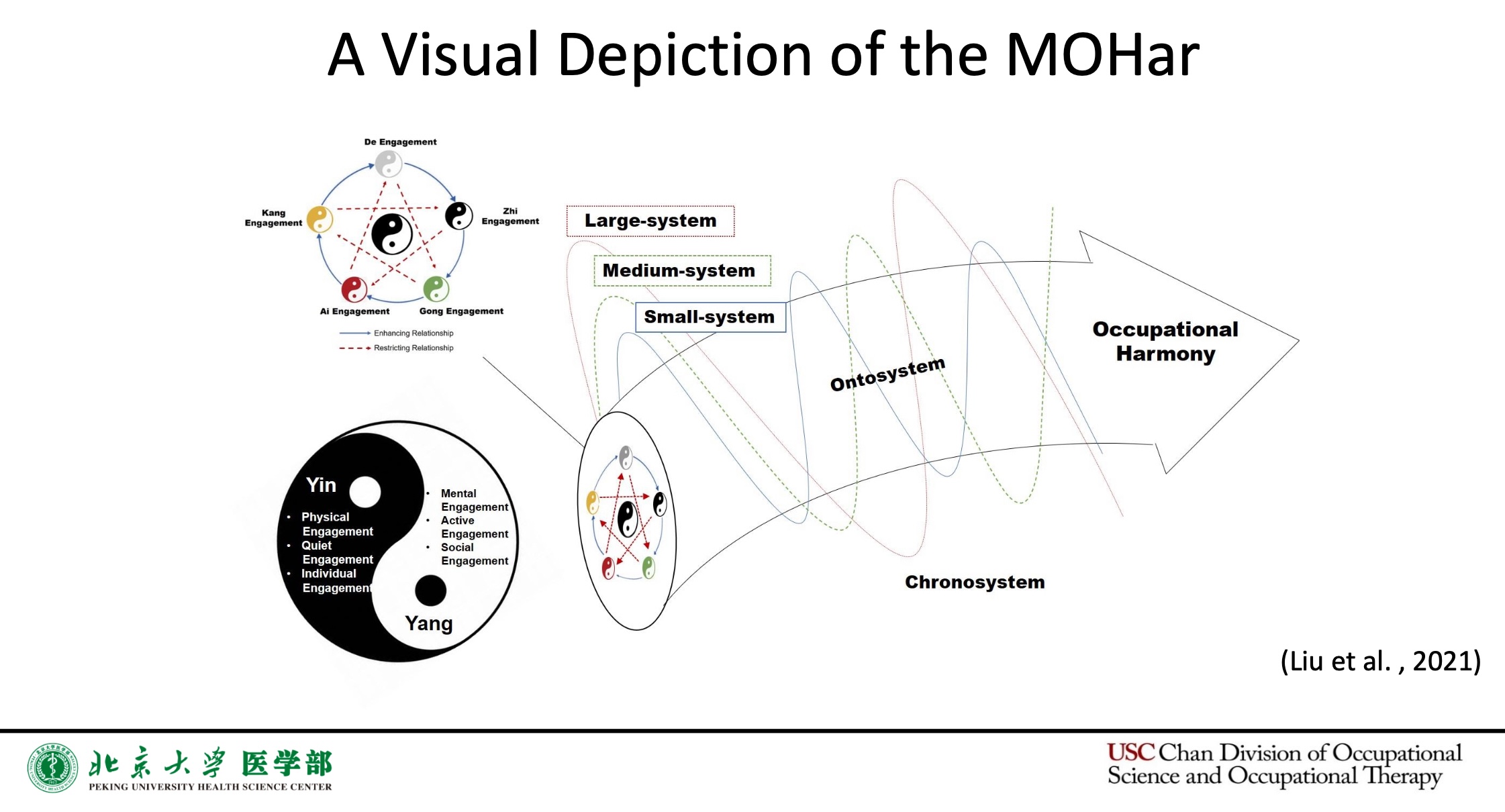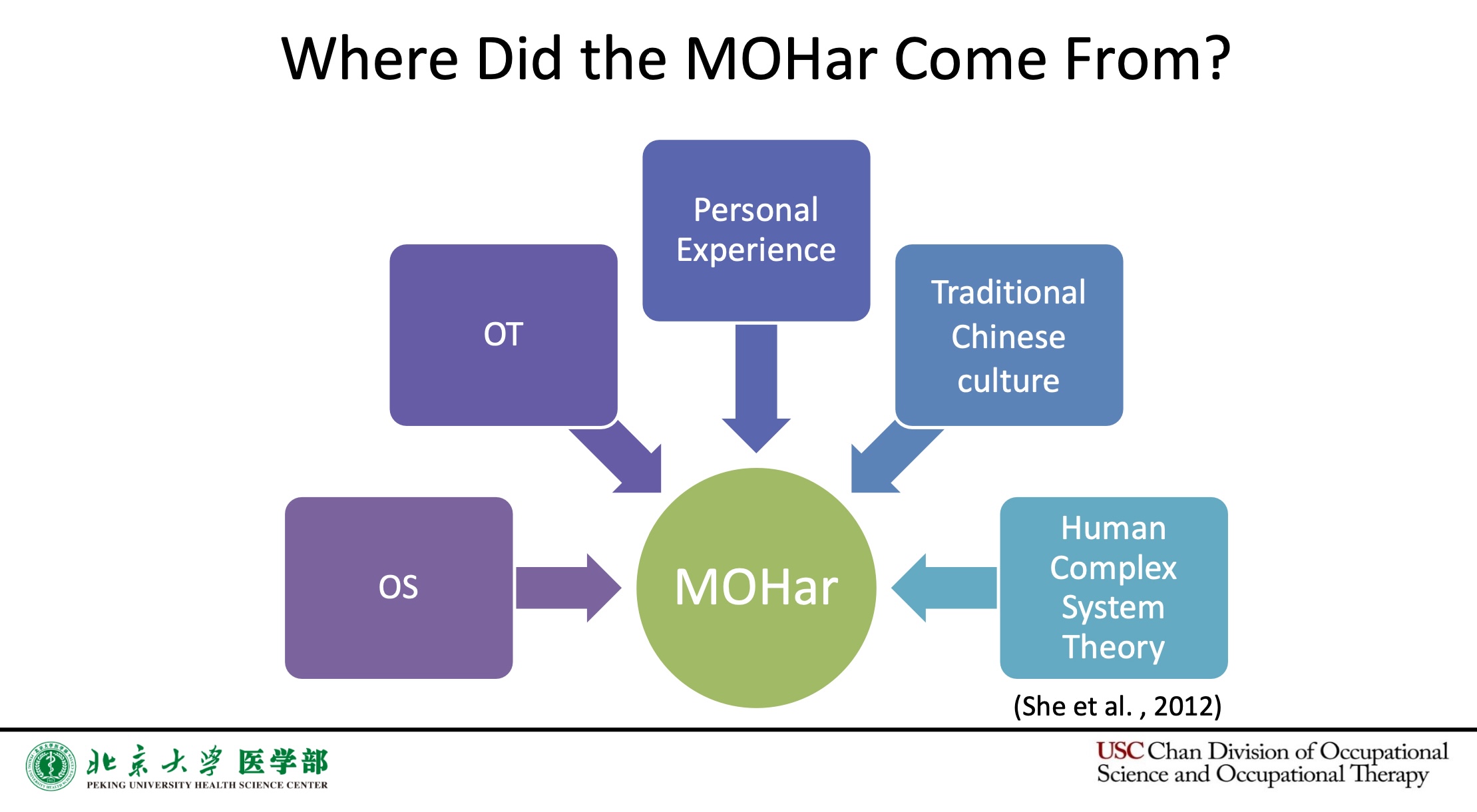Q&A with the author of the Model of Occupational Harmony, Dr Yijun Liu
November 11, 2023
Dr. Yijun Liu, author of the Model of Occupational Harmony (MOHar), shared her perspectives on the development and future of MOHar in an interview with the China Initiative.
China Initiative Health and Wellness International
The China Initiative invited Dr. Yijun Liu, author of the Model of Occupational Harmony (MOHar) and an instructor in the USC-PKUHSC dual-degree program, to share her vision for the development of MOHar and its application in the field of occupational science (OS) globally.
The MOHar is a conceptual model developed to add an Eastern perspective to the understanding of occupational balance, a construct frequently addressed in OS literature. The model consists of three domains grounded in traditional Chinese cultural beliefs and Chinese Scholars’ Human Complex System Theory: (1) Yin Yang “阴阳”, (2) the five-element theory or Wu Xing “五行”, and (3) The unity of nature and human with coherence across multi-level systems or Tian-Ren-He-Yi “天人合一”. According to Dr. Liu, Yin and Yang reflect opposing occupational characteristics in occupations. Three essential pairs of occupational characteristics are proposed: (1) physical and mental engagement, (2) quiet and active engagement, and (3) individual and social engagement; the equilibrium between these two-sided occupational characteristics leads to a harmonious state. According to Wu Xing, five dimensions of occupational engagement, virtue (de), rationality (zhi), action (gong), emotion (ai), and health maintenance (kang) interact to enhance or restrict each other. The coherence across multilevel systems, also called transactions, describes how a person (ontosystem) interacts with small systems like family and classmates, medium systems like school and work, and large systems, like society, countries, and the world. The chronosystem combines the past, the current, and the future. A state of occupational harmony is achieved through an equilibrium between Yin and Yang, a balanced Wu Xing, and good coherence across the multilevel systems.
The concept of occupational harmony was inspired by Dr. Liu’s personal experience of overcoming challenges, especially adapting to cultural differences when she pursued her master’s and doctoral degrees in occupational therapy (OT) at USC from 2017 to 2019. Although she was learning Western medicine as a medical student in China prior to studying abroad in the US, her extensive interest in traditional Chinese medicine, philosophy, and culture led her to view occupational balance from a perspective different from those in readings and discussions with her instructors and classmates. Dr. Liu’s knowledge of systems theory and complex thinking influenced her to develop a model that reflects a more nuanced understanding of the complexity of balance in everyday occupation.These lived experiences ultimately led to the conceptualization of MOHar.
It was an honor to engage in an in-depth conversation with Dr. Liu on her experience of applying the MOHar in different aspects of her life, including through teaching students at PKUHSC and practicing with clients to improve their health. In this interview, Dr. Liu walked us through her insights into the improvements of MOHar, as well as the rewarding moments of her work and advice to those who are interested in the model.
Q: What are some ways in which you have applied the Model of Occupational Harmony in clinical practice, research, or pedagogy? What are some potential additional areas of research or practical interventions that could benefit from the Model of Occupational Harmony?
A: I used the MOHar with my students at Peking University. The OT master’s students learned to apply the model through self occupational analysis in their health promotion and wellness class. Some of them continued to utilize it in their lives to promote their own harmony and balance. I encouraged these future practitioners to incorporate this model in their future research and clinical practice. Students with different majors and backgrounds mainly use it for improving health and wellness. I think it is good for young adults and teenagers in transitional stages since mental health is a significant need in this population. Another population that can benefit is older adults, helping them to engage in active and productive aging. This is an area that I would like to explore more considering aging is a global issue. Dr. Ruth Zemke and I named it “harmonious aging”.
Q: What have been the reactions to your work? Have there been any challenges or critiques that you’ve encountered in developing or promoting the concept of Occupational Harmony?
A: My work is very well-accepted because it adds an Eastern perspective to help tackle the complexity of occupational balance; although there were some suggestions on how to revise it when I first submitted the manuscript. In China, the vast majority of the medical field only considers natural science like biology as science. When you talk about culture or something about daily life, most of them do not see it as science, but more like a humanistic subject. Their lack of recognition in social science leads to a shortage of models like the MOHar. Proposing a theoretic model based on traditional culture and system theory is a deductive approach, which is not seen as “that scientific”. This is very different from how the Chinese medical field usually develops a model and generalizes some core principles based on a lot of experiments and practices.
Another criticism from the Chinese society, mostly from physicians in rehabilitation medicine, is that the definitions in this model are too subjective and all defined by me and my coauthors. I think there should be a paradigm shift, but people are still in the old paradigm and holding deep beliefs toward their traditional knowledge. Nonetheless, the MOHar is actually very welcomed in the OT and OS fields. Conferences would invite me to give presentations and the Chinese Occupational Therapy Association expressed interest in promoting the model.
Q: What do you envision for the future of Occupational Harmony in terms of research, practice, and its impact on occupational science? How do you see this model contributing to occupational science? Are there plans for further development or refinement of the model based on ongoing research or feedback?
A: How will this model be accepted, used and modified in different cultures? The concept of Yin Yang and Wu Xing are natural beliefs that are normal in Chinese culture. It is interesting to see people from different countries reading this paper and citing it in their own research. I feel like this is the initial step of globalization. When I was learning about frames of reference, I found them theoretical and difficult to come up with intervention plans. You need to prepare another set of mind, techniques or theories to do so. Using the MOHar, your analysis can be easily turned into a plan and directly applied to promote occupational harmony. It is straightforward and practical, as it can be both an analyzing tool and an intervention plan to address occupational patterns and overall lifestyle. Those who do not know about OT or OS often have a question regarding how occupations can promote health. Previous models all focus on analyzing occupations or the interaction between person, environment, and occupations, but fail to give an explanation on how these altogether are related to health. The MOHar demonstrates a clear relationship between occupational harmony and health. The model is at its initial stage and I take criticism as nutrition for further refinement. For instance, there is a need for operational definitions of five-dimensional engagement to classify different occupations. More research is needed to test practicality and validity for supporting evidence.
Q: What has been the most rewarding aspect of your work on Occupational Harmony?
A: I think it is most rewarding to myself and my occupational harmony. From having the idea to developing this model, I wrote a manuscript and later did my dissertation research to apply it in practice. All these experiences coming together made me feel like the transactions of my different systems are in a better harmonial stage. When I applied it with my students and clients, I saw them being better, healthier and happier by the end. When I see people from different cultural backgrounds are interested in how traditional Chinese philosophy and cultures are used in OT and OS fields through this model, I feel very happy about it. Even though people from different countries speak different languages, a happy and healthy life is what everyone is pursuing. Something I can contribute is to help them achieve that in their lives. My dream is “healthy occupations, everybody, everyday, everywhere”. I am doing what I need to do and this fulfills the meaning and goal of my life.
Q: Is there any final message you’d like to share with professionals, researchers, or students interested in the concept of Occupational Harmony?
A: I want to share a Chinese old saying “知行合一”, which means “your action aligns with what you believe in”. If you are interested in the concept of occupational harmony, apply it in your practice. Clients believe in our professionalism. How can they trust your ability to manage their health and wellness when you cannot do it yourself? Health is very important, not only to yourself, but also for everyone in your family, your work unit, and in your school, because you will influence others.
Dr. Liu is passionate about improving the health and wellness of her students and her clients through promoting the concept of occupational harmony, as well as the development and application of MOHar with different populations and in different cultural contexts. Her work has contributed to OS research on occupational balance with her unique personal experiences and in-depth understanding of Chinese philosophy. Dr. Liu calls for fellow practitioners to use a holistic approach in understanding factors contributing to better health and well-being of themselves and others.
References of Dr Yijun Liu’s publications related to the Model of Occupational Harmony
Liu, Y., She, R., & Xing, J. (2023). Analysis of University Students’ Mental Health from the Perspective of Occupational Harmony. Peking University First Hospital. [Manuscript in preparation].
Liu, Y. (2021). Zuoye hexie shijiao xia de daxuesheng xinli jiankang wenti fenxi yu duice chutan [Analysis of University Students’ Mental Health Problems and Exploration of Intervention Strategies from the Perspective of Occupational Harmony]. Peking University. [Unpublished doctoral dissertation].
Liu, Y., Zemke, R., Liang, L., & Gray, J. M. (2021a). Model of occupational harmony: A Chinese perspective on occupational balance. Annals of International Occupational Therapy, 4(4), e228–e235. https://doi.org/10.3928/24761222-20210601-08
Liu, Y., Zemke, R., Liang, L., & Gray, J. M. (2021b). Occupational harmony: Embracing the complexity of occupational balance. Journal of Occupational Science, 30(2), 145–159. https://doi.org/10.1080/14427591.2021.1881592
⋯
Next by tag China Initiative ⟩ Health and Wellness ⟩ International ⟩







